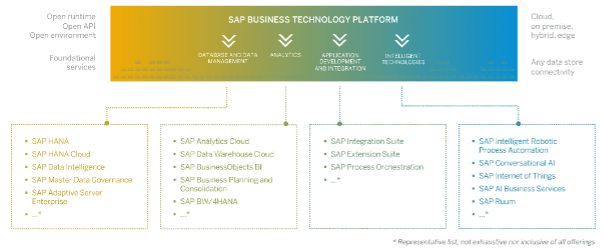Organizations considering an SAP implementation will make many choices between first identifying a need and finally going live.
“We must all make the choice between what is right and what is easy.”
-Professor Dumbledore, Harry Potter
With deference to Prof. Dumbledore, the choice of an SAP licensing model isn’t always that clear.
The SAP® Business Technology Platform (BTP) combines the four pillars of data and analytics, application development, and integration in one unified environment.
Each pillar is a unique combination of products and services. Some pillars are delivered together, and others stand alone. As a suite, SAP BTP may mean something different to a customer depending on how the offerings are presented.

The SAP BTP cockpit is the central entry point to all these services. This is where a system administrator accesses and manages subscriptions and applications.
BTP Commercial Models Overview
To support customers with different needs, SAP offers a range of options for licensing their Business Technology platform. Options are primarily subscription-based and consumption-based.
SaaS Subscriptions
SAP formerly offered Software as a Service (SaaS) via subscriptions only. They felt customers had well-defined use cases for achieving their goals.
Purchasing an HRIS like SuccessFactors wouldn’t require input from other lines of business.
Many companies continue to use SAP on a subscription basis.
Thinking Past Subscriptions
Today’s cloud-based offerings require you to rethink how your business could run better. Cloud-based technology platforms can improve business processes, performance, and adaptability.
A cloud-based technology platform can provide:
- Flexibility of scaling data storage up when needed and scaling back when not needed
- World-class data security, compliance, and availability
- Elastic, pay-for-use pricing
- Ease of integration with other systems in the technology stack, increasing efficiency
- Better insights from data analysis
- Efficiencies from automating manual, non-value-added processes
- Faster implementation than on-premise software
These are some reasons SAP came up with new commercial models to support every customer.
SAP now offers consumption-based licensing as an alternative to subscription-based licensing.
SAP Cloud Platform Enterprise Agreement (CPEA)
CPEA SAP’s first consumption-based pricing model. It lets customers buy, consume, and pay based on their use (with an upfront commitment.)
CPEA reduces complexity and costs with self-provisioning and real-time usage and recording. Customers can turn the services they need on and off, then pay for what they consume.
This model works like a debit card. Customers put funds in, and they’re debited for what they use every month.
Pay As You Go (PayGo)
The final commercial model SAP offers is Pay As You Go (PayGo).
There is no up-front commitment. Like when using a credit card, the customer is billed every month for the services they’ve consumed. There is a premium charged for the convenience of not having to commit.
A Quick Comparison
Pay As You Go | CPEA | Single Service Subscription |
|
|---|---|---|---|
| Type | Zero Commit | Commit to Consume | Fixed Commitment |
| What is it? | Build small-scale apps with access to 85+ SAP BTP services, paying only for services used. | Integrate and extend solutions at scale with access to 85+ SAP BTP services, paying less by committing upfront to use more. | Integrate and extend solutions at scale with individual SAP BTP services, making a fixed commitment. |
| When to use it? | Proof of concepts, small-scale pilots. | Multiple use-cases, expanding over time with predictable usage of results. | Specific use case with known usage of individual services. |
| Customer Benefit? | No upfront cost, pay only for services used. Minimize initial budget outlay, low risk. | Flexibility in using services, multiple services in single SKU. | Conscious decision to purchase a dedicated product. |
Different Yet the Same
Users access and administer the system the same way matter the licensing model. The SAP BTP cockpit looks the same. The only difference is how the business is charged.
If you find yourself short of magic wands to help you decide which licensing model suits you best, have no fear! Contact us – we’d be happy to help you slay your business process monsters.

